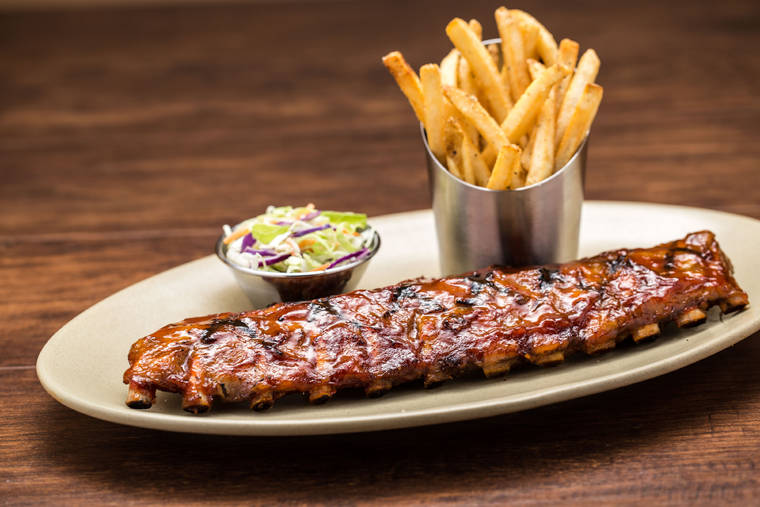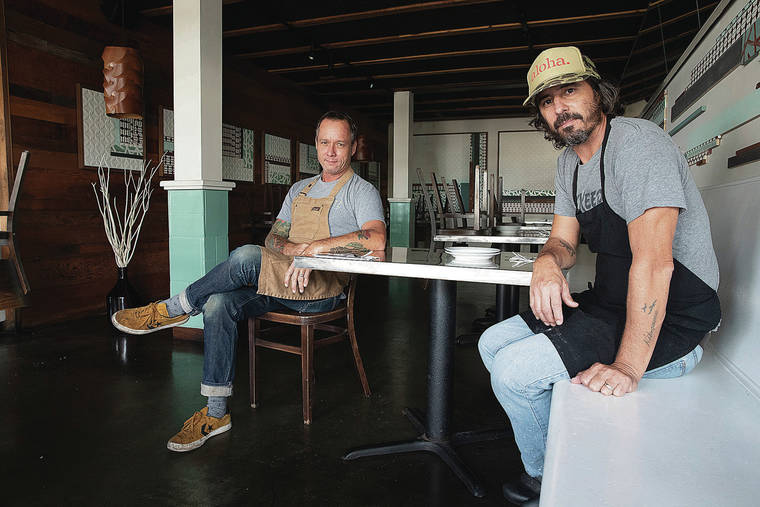The loss of a restaurant means more than good food gone missing. Our writers recall their personal connections to three favorite dining places lost to the pandemic.
TOWN OFFERED FOOD FOR THOUGHT
In pondering the loss of Town, the farm-to-table Kaimuki restaurant that deliciously immersed us in food policy, it quickly becomes apparent that while the restaurant itself is shuttered, there’s no putting the genie back in the bottle. Town’s influence on Hawaii’s restaurant scene looms large and lasting because it led diners to another level of relationship with the food they ate.
When Town came along in 2005, it was more than a decade after the creation of the Hawaii Regional Cuisine movement, established by isle chefs who found inspiration in local flavors and took them upscale using the pristine products grown, raised and caught in the isles.
Because of HRC, when the restaurant opened, diners were already schooled in the merits of locally grown food. But Town’s chef-owners, Ed Kenney and Dave Caldiero, changed the game, adding depth to that education: They redirected the spotlight from superstar chefs and their dazzling dishes to the products and growers. They used their own formidable talents to create homey, often pared-down preparations, all wonderfully delicious, to show the ingredients in their best light.
Their choices about what was served — “local first, organic when possible, with aloha always” — required diners to make a commitment as well. Driven by ethics, Town sourced from producers who cared not only about the quality of the food they provided, but how their practices affected the planet. It committed to supporting those farmers by purchasing what they had available.
That meant if you wanted to eat at Town, you had to be flexible about what was on your plate. And that made customers accountable to the food system as well — showing them there is relevance to what they decide to put on their forks, and that each of us has a stake in the food system.
Town’s approach to food appealed to our intellect and highest sensibilities. More than simply educating us, the restaurant’s mandate helped us develop values about food.
And the thing is, when you decide to eat something that not only tastes good, but is good for your health, supports ethical food producers and is good for the planet, the nourishment extends beyond the body to the spirit. Food values become a part of who you are, not just what you know, when you’re actually ingesting food prepared by honoring those values.
Though I have favorite menu items, I chose not to use this limited space to include them. To my mind, Town’s mark on this community is less about the countless wonderful meals served and mostly about the wisdom imparted. In the end, I think those who took to heart the lessons that Town provided were made better people for it. What more could you ask of a restaurant?
— Joleen Oshiro, Star-Advertiser
TONY ROMA’S WAS PLACE FOR CELEBRATION
Tony Roma’s was most often the restaurant where I celebrated my birthday, met with friends or feasted with relatives on Thanksgiving. So when the franchise’s last restaurant in Waikiki suddenly closed in October, I joined the chorus of fans groaning about the demise of another favorite.
All those long racks of fall-off-the bone baby back ribs, dripping in Carolina Honey Sauce, the loaf of fried onion rings, cheesy baked potato soup and tangy coleslaw were gone for good. It was the type of party food that left you stuffed and sighing, a little sad when it was gone.
My co-worker, Lorenzo Trinidad, was just as heartbroken about the closure. He’d been celebrating his birthdays at the restaurant for about 35 years, continuing a family tradition started by his late great-aunt. His favorites were the tender baby backs (but with the classic, original sauce), onion rings and baked potato soup, too.
The sinful side dishes were just as important to relishing the meal, because no one should have to eat ribs alone. Options included baked beans, a loaded baked potato, fries and corn on the cob, and always, the warm, yeasty rolls with herb butter that came with the meal.
“This year (2020), even with COVID, we did takeout for my birthday in April,” Lorenzo, who’s 44, told me at the time of the closure. “I grew up eating baby back ribs.” He and his wife tried to get their last fix of ribs, showing up at Tony Roma’s when they couldn’t get through on the phone, but found the food already sold out.
The Waikiki branch on Kalakaua Avenue was the first of four locations to open in the state 48 years ago. When our favorite location in Kahala closed over 10 years ago, Lorenzo and I switched to the Aiea branch, then that closed about five years ago. Ever the diehard, he kept going to the Waikiki branch, which deterred me because of the tiny parking lot.
The silver lining of this story is that WDI International, which owned Tony Roma’s, has another restaurant called TR Fire Grill Waikiki, which began serving Tony Roma favorites when it re-opened in January. Fire Grill features smoked prime rib, steaks, seafood and affordable lunch deals.
I couldn’t wait to see if the Tony Roma’s specialties were just as good there. The ribs were just as well executed, as was the onion loaf. But I couldn’t get my go-to Carolina Honey Sauce; the ribs were only offered with the classic barbecue sauce. And only french fries were offered as a side starch — no beans or baked potato. I was also disappointed that the coleslaw lacked its signature zest, and they were out of baked potato soup.
Other former Tony Roma’s specialties on the TR menu are Kickin’ Shrimp, beef short ribs, barbecued half-chicken and rib combo meals (with chicken and lobster tail).
I didn’t get the same full-blown satisfaction that used to come with a Tony Roma’s meal, but I was served a taste of nostalgia, with nice ambience, terrific service, comparable prices and validated parking.
TR Fire Grill Waikiki is in the Hilton Garden Inn Waikiki Beach, 2330 Kuhio Ave.; 744-3300.
— Pat Gee, Star-Advertiser
LIKE LIKE SERVED COMFORT BY THE BOWL
This happened seemingly every time I went to Like Like Drive Inn in the 1980s and told the waitress what I wanted:
“Eh boy … you sure you like eat dat?”
I’d respond respectfully.
“Yes, ma’am.”
Back then, ma’am was always considered polite. We didn’t address older women we didn’t know as auntie. And I didn’t know I was supposed to be offended by her calling me boy. All I knew was I wanted to eat, and at Like Like, I always knew exactly what I wanted to eat: oyster stew.
“You sure, boy? You know what it is? It’s not real stew, you know.”
I’d do my best to convince her.
“Yes, I’m sure, thank you. My father was from Boston and I grew up eating it. Plus, you’ve served it to me here several times and I’ve always eaten it all.”
She’d amble away to tell the cook some crazy kid ordered oyster stew, shaking her head in her certainty that I had no idea what I was getting myself into.
New England-style oyster stew is a very simple dish. Oysters, butter, milk. When it’s placed in front of you, you add crackers, pepper and maybe Worcestershire sauce. It’s basically clam chowder, except with oysters and without potatoes or anything else.
That’s why the waitresses at Like Like interrogated me every time. They’d witnessed enough confusion and disappointment after serving a bowl of white chowder to a customer expecting something brown or red.
I could have avoided the questioning and gone somewhere else for my monthly oyster stew. But somewhere else would have to be home, and making it myself was not an attractive option at 2:30 a.m. At that time of night, Like Like was one of the few restaurants open and a good bet to be the only one within about a 2,500-mile radius with oyster stew on the menu.
It wasn’t as good as my mom’s, of course. She’d learned to cook New England-style from my dad’s mom after they got married. But it brought back memories of him and the many delicious foods he and Mom introduced me to before he died in 1981 when I was 19.
The oyster stew eventually disappeared from the menu at Like Like; no surprise, especially given the promotional efforts of the waitstaff. I was grateful it had ever been available at all, because it made no sense. It must have been something that James or Alice Nako, or one of their friends, liked when they opened the place in 1953.
In the context of the rest of the menu — the quintessential collection of local standards like hamburger steak and saimin — it made me think of that old “Sesame Street” song: “One of these things is not like the others. One of these things just doesn’t belong.”
When Like Like Drive Inn closed last year during the pandemic it brought back memories for just about everyone. For me, of my dad and oyster stew.
I also thought about my softball friend, the legendary entertainer Jimmy Borges. Once in awhile we’d get together there.
Yeah, he lived right around the corner, and it was a convenient place for him to grab a bite on the way home after a late gig. But he really loved it for the same reason we all did. They didn’t just serve comfort food, they served comfort.
And if the waitress wanted to make sure you knew what you were ordering, she wasn’t trying to annoy you. She was just trying to look out for you, the way any good auntie does.
— Dave Reardon, Star-Advertiser






